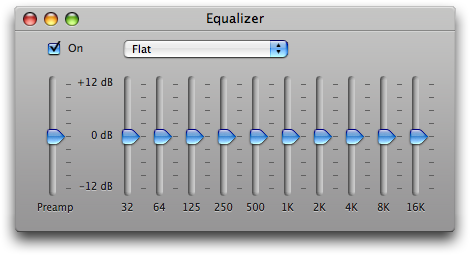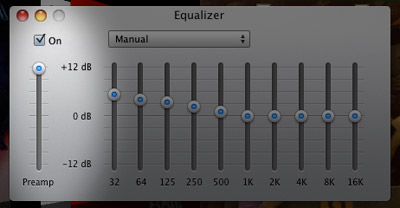- Today I finally figured out how to get a global system equalizer for OS X (for free) so I can push the bass up a little to compensate for the 'emptiness'. These steps are done on a Snow Leopard iMac (10.6.7 specifically) but I'm pretty sure they would work on a Tiger/Leopard (10.4/10.5) machine as well.
- Free Audio Equalizer for macOS. Download Take a tour. By Downloading and installing eqMac you automatically agree to our Terms and Conditions. 600k+ Downloads 50k+ Users. Frequently asked questions: Question: What is the point eqMac? What is an Audio Equalizer?
Apple technology has always been notable for its simplicity and ease of working with multimedia. The revolution of the iPod player is not only in its compactness, but also in the quality of the reproduced sound.


The ergonomics and minimal thickness of the iPad or MacBook Air did not prevent the company from installing decent speakers and taking care of good sound on mobile devices. Decent mobile sound is a nightmare for audiophiles, but we will not consider ourselves as music lovers in this category, and in today's instructions we'll just do our best to squeeze the maximum out of the MacBook speakers.
The options for achieving good sound are somewhat demanding to understand what you are doing. By 'good sound' I mean one that is significantly louder than the maximum allowed value of Apple-limited sound that has volume and a balanced frequency picture.

Improving the Sound of macOS using Equlization
In order to play over the sound of your MacBook, you can use the free alternative. The only 'but' – you will need two applications at once and minimal skills to work with sound plug-ins. If you are ready – feel free to fight!
Experience your audio in 3D. With the best volume booster, equalizer & bass booster, experience your Movies, Music and Games in cinematic surround sound on your laptop, desktop or mobile.
Sound Equalizer For Mac Os X
Attention! I'm not responsible for any hardware and software damage to your devices. Abuse of volume can harm the dynamics of your laptop. Please be attention with settings!
Read more:Fix Audio & Sound Issues on your Mac
We will need the Soundflower application that emulates an additional sound card in the MacBook and a virtual distributor of audio ports — Apple's AU Lab application:
- Download Soundflower;
- Install and reboot the computer;
- Download Apple's AU Lab;
- Go to Settings -> Sound. For Output, choose Soundflower;
- Open the AU Lab application and set the settings as follows: as the input signal (Audio Input Device), select the installed Soundflower and as the output signal (Audio Output Device) select the Built-in output;
- Click Create and see a window with two bands – the mixer of our audio signals. Raise the volume sliders to the maximum;
- Now our task is to enhance the sound. We will use the plug-ins built into the system (subject to Garageband installed). For sophisticated users working with sound processing, you can use any 'best plug-ins.' On the Output 1 track, in the Effects field, select the AUNBandEQ plugin;
- In the plug-in window that opens, the Global Gain slider is raised to 24 decibels. If the received volume is not enough – we catch another plug-in in the appeared free field of effects and amplify it;
- Attention!!! Do not overdrive it! Overdriv of sound, wheezing and plunging suggests that the volume level is too high for speakers installed in a MacBook;
- Now you need to put the equalizer plugin and build it the way your ears want. Choose AUGraphicEQ;
- Turn on your favorite song, switch the equalizer to 10 bands and move the sliders, adjusting a sufficient number of low, mid and high frequencies;
- After finishing the settings in the AULab application, select File -> Save and specify the directory to save all the settings of your profile.
Conclusion
In the future, when you open the AU Lab, you can use it. There was a long way, but we did it! My Congrats!
Ever wish you had a system wide equalizer to adjust all audio output in Mac OS X and not just in iTunes? Maybe you want to adjust the way all audio output sounds or maybe you just want to boost the output volume of the built-in Mac speakers. We'll show you how to do both by creating your own universal EQ using two free tools, follow along:
Requirements
- Soundflower – free download from Google Code
- AU Lab – free download from Apple Developers (requires free Apple Dev ID)

The ergonomics and minimal thickness of the iPad or MacBook Air did not prevent the company from installing decent speakers and taking care of good sound on mobile devices. Decent mobile sound is a nightmare for audiophiles, but we will not consider ourselves as music lovers in this category, and in today's instructions we'll just do our best to squeeze the maximum out of the MacBook speakers.
The options for achieving good sound are somewhat demanding to understand what you are doing. By 'good sound' I mean one that is significantly louder than the maximum allowed value of Apple-limited sound that has volume and a balanced frequency picture.
Improving the Sound of macOS using Equlization
In order to play over the sound of your MacBook, you can use the free alternative. The only 'but' – you will need two applications at once and minimal skills to work with sound plug-ins. If you are ready – feel free to fight!
Experience your audio in 3D. With the best volume booster, equalizer & bass booster, experience your Movies, Music and Games in cinematic surround sound on your laptop, desktop or mobile.
Sound Equalizer For Mac Os X
Attention! I'm not responsible for any hardware and software damage to your devices. Abuse of volume can harm the dynamics of your laptop. Please be attention with settings!
Read more:Fix Audio & Sound Issues on your Mac
We will need the Soundflower application that emulates an additional sound card in the MacBook and a virtual distributor of audio ports — Apple's AU Lab application:
- Download Soundflower;
- Install and reboot the computer;
- Download Apple's AU Lab;
- Go to Settings -> Sound. For Output, choose Soundflower;
- Open the AU Lab application and set the settings as follows: as the input signal (Audio Input Device), select the installed Soundflower and as the output signal (Audio Output Device) select the Built-in output;
- Click Create and see a window with two bands – the mixer of our audio signals. Raise the volume sliders to the maximum;
- Now our task is to enhance the sound. We will use the plug-ins built into the system (subject to Garageband installed). For sophisticated users working with sound processing, you can use any 'best plug-ins.' On the Output 1 track, in the Effects field, select the AUNBandEQ plugin;
- In the plug-in window that opens, the Global Gain slider is raised to 24 decibels. If the received volume is not enough – we catch another plug-in in the appeared free field of effects and amplify it;
- Attention!!! Do not overdrive it! Overdriv of sound, wheezing and plunging suggests that the volume level is too high for speakers installed in a MacBook;
- Now you need to put the equalizer plugin and build it the way your ears want. Choose AUGraphicEQ;
- Turn on your favorite song, switch the equalizer to 10 bands and move the sliders, adjusting a sufficient number of low, mid and high frequencies;
- After finishing the settings in the AULab application, select File -> Save and specify the directory to save all the settings of your profile.
Conclusion
In the future, when you open the AU Lab, you can use it. There was a long way, but we did it! My Congrats!
Ever wish you had a system wide equalizer to adjust all audio output in Mac OS X and not just in iTunes? Maybe you want to adjust the way all audio output sounds or maybe you just want to boost the output volume of the built-in Mac speakers. We'll show you how to do both by creating your own universal EQ using two free tools, follow along:
Requirements
- Soundflower – free download from Google Code
- AU Lab – free download from Apple Developers (requires free Apple Dev ID)
Download and install both Soundflower and AU Lab, you will then need to restart your Mac to have full access to the audio components. Once rebooted, follow along with the instructions below:
Set Up a Universal Audio Equalizer for Mac OS X
- Set System Volume to the maximum level, do this either through the menu bar or by hitting the Volume Up key repeatedly.
- Open System Preferences from the Apple menu and select the 'Sound' panel, followed by the 'Output' tab. Select 'Soundflower (2ch)' from the Output list.
- Now launch AU Lab, found in
/Applications/Utilities/. - From the 'Audio Input Device' pulldown menu, select 'Soundflower (2ch)', and then from 'Audio Output Device' menu select 'Stereo In/Stereo Out'.
- Click the 'Create Document' button at the bottom of the screen.
- At the next screen, look for 'Output 1' column and click the 'Effects' dropdown, selecting 'AUGraphicEQ'.
- This is your new system-wide equalizer, set it how you see fit. Changes here will impact all audio output on the Mac.
- When satisfied with the EQ settings, hit Cmd-S to save the EQ settings file and put it somewhere easy to find, like the Documents folder.
- Now open AU Lab preferences from the AU Lab menu, click on the 'Document' tab and click the radiobox next to 'Open a specific document', selecting the .trak EQ file you saved in the previous step.
Optional final step: If you want the EQ settings to load on every Mac OS X boot, right-click on the AU Lab icon, go to Options, and select 'Open at Login'.
Audio Equalizer For Mac Os X
It's important to note that AU Lab must be running in order for the equalizer to have an effect, keeping it running will consume a small amount of CPU resources but it's much less process hungry than some of the third party alternatives available on the market.
